Land Use Evolution and Its Driving Factors over the Past 30 Years in Luochuan County
Abstract
:1. Introduction
2. Materials and Methods
2.1. Study Area
2.2. Data Analysis Process
2.3. Data Source
- (1)
- Acquisition of Remote Sensing Images
- (2)
- DEM Data
- (3)
- Land Use Data
- (4)
- Meteorological Data
2.4. Land Use Transfer Matrix
2.5. Grey Relation Analysis
i = 1, 2, ……, m − 1; m; j = 1, 2, ……, n
i = 1, 2, ……, m − 1, m; j = 1, 2, ……, n
2.6. Regression Model
2.7. Data Analysis
3. Results
3.1. Land Use and NDVI in Luochuan County over the Past 30 Years
3.2. Spatial Transfer Changes in Land Use in Luochuan County over the Past 30 Years
3.3. Evolution of Land Use Information Entropy in Luochuan County over the Past 30 Years
3.4. Evolution of Dominance Index of Land Use in Luochuan County over the Past 30 Years
3.5. Driving Factors of Land Use Change in Luochuan County
4. Discussion
4.1. Land Use Evolution over the Past 30 Years in Luochuan County
4.2. The Driving Factors of Land Use Change during the Past 30 Years in Luochuan County
4.3. Limitations
5. Conclusions
Author Contributions
Funding
Data Availability Statement
Conflicts of Interest
References
- Zhou, Y.; Li, X.; Liu, Y. Land use change and driving factors in rural China during the period 1995–2015. Land Use Policy 2020, 99, 105048. [Google Scholar] [CrossRef]
- Wang, X.; Wu, J.; Liu, Y.; Hai, X.; Shanguan, Z.; Deng, L. Driving factors of ecosystem services and their spatiotemporal change assessment based on land use types in the Loess Plateau. J. Environ. Manag. 2022, 311, 114835. [Google Scholar] [CrossRef]
- Xie, L.; Wang, H.; Liu, S. The ecosystem service values simulation and driving force analysis based on land use/land cover: A case study in inland rivers in arid areas of the Aksu River Basin, China. Ecol. Indic. 2022, 138, 108828. [Google Scholar] [CrossRef]
- Niu, X.; Hu, Y.; Lei, Z.; Wang, H.; Zhang, Y.; Yan, H. Spatial and temporal evolution characteristics of land use/cover and its driving factor in Cambodia during 2000–2020. Land 2022, 11, 1556. [Google Scholar] [CrossRef]
- Dong, Z.; Rong, A.; Zhang, J.; Tong, Z.; Han, A.; Zhi, F. Study on the Evolutionary Features and Driving Factors of Land-Use System in Xilingol, China. Land 2022, 11, 526. [Google Scholar] [CrossRef]
- Zhou, X.; Wu, D.; Li, J.; Liang, J.; Zhang, D.; Chen, W. Cultivated land use efficiency and its driving factors in the Yellow River Basin, China. Ecol. Indic. 2022, 144, 109411. [Google Scholar] [CrossRef]
- Wu, J.; Luo, J.; Zhang, H.; Qin, S.; Yu, M. Projections of land use change and habitat quality assessment by coupling climate change and development patterns. Sci. Total Environ. 2022, 847, 157491. [Google Scholar] [CrossRef]
- Zhang, S.; Yang, P.; Xia, J.; Wang, W.; Cai, W.; Chen, N.; Zhan, C. Land use/land cover prediction and analysis of the middle reaches of the Yangtze River under different scenarios. Sci. Total Environ. 2022, 833, 155238. [Google Scholar] [CrossRef] [PubMed]
- Long, X.; Lin, H.; An, X.; Chen, S.; Qi, S.; Zhang, M. Evaluation and analysis of ecosystem service value based on land use/cover change in Dongting Lake wetland. Ecol. Indic. 2022, 136, 108619. [Google Scholar] [CrossRef]
- Li, X.; Fu, J.; Jiang, D.; Lin, G.; Cao, C. Land use optimization in Ningbo City with a coupled GA and PLUS model. J. Clean. Prod. 2022, 375, 134004. [Google Scholar] [CrossRef]
- Allan, A.; Soltani, A.; Abdi, M.H.; Zarei, M. Driving forces behind land use and land cover change: A systematic and bibliometric review. Land 2022, 11, 1222. [Google Scholar] [CrossRef]
- Hao, J.; Lin, Q.; Wu, T.; Chen, J.; Li, W.; Wu, X.; Hu, G.; La, Y. Spatial–temporal and driving factors of land use/cover change in Mongolia from 1990 to 2021. Remote Sens. 2023, 15, 1813. [Google Scholar] [CrossRef]
- Zhou, Y.; Zhong, Z.; Cheng, G. Cultivated land loss and construction land expansion in China: Evidence from national land surveys in 1996, 2009 and 2019. Land Use Policy 2023, 125, 106496. [Google Scholar] [CrossRef]
- Hishe, H.; Giday, K.; Van Orshoven, J.; Muys, B.; Taheri, F.; Azadi, H.; Feng, L.; Zamani, O.; Mirzaei, M.; Witlox, F. Analysis of land use land cover dynamics and driving factors in Desa’a forest in Northern Ethiopia. Land Use Policy 2021, 101, 105039. [Google Scholar] [CrossRef]
- Wang, Q.; Wang, H.; Chang, R.; Zeng, H.; Bai, X. Dynamic simulation patterns and spatiotemporal analysis of land use/land-cover changes in the Wuhan metropolitan area, China. Ecol. Model. 2022, 464, 109850. [Google Scholar] [CrossRef]
- Zhou, J.; Gao, P.; Wu, C.; Mu, X. Analysis of land use change characteristics and its driving forces in the loess plateau: A case study in the yan River Basin. Land 2023, 12, 1653. [Google Scholar] [CrossRef]
- Jiang, W.; Fu, B.; Lü, Y. Assessing impacts of land use/land cover conversion on changes in ecosystem services value on the Loess Plateau, China. Sustainability 2020, 12, 7128. [Google Scholar] [CrossRef]
- Ren, Y.; Lü, Y.; Fu, B.; Comber, A.; Li, T.; Hu, J. Driving factors of land change in China’s loess plateau: Quantification using geographically weighted regression and management implications. Remote Sens. 2020, 12, 453. [Google Scholar] [CrossRef]
- Sun, W.; Ding, X.; Su, J.; Mu, X.; Zhang, Y.; Gao, P.; Zhao, G. Land use and cover changes on the Loess Plateau: A comparison of six global or national land use and cover datasets. Land Use Policy 2022, 119, 106165. [Google Scholar] [CrossRef]
- Huang, H.; Zhou, Y.; Qian, M.; Zeng, Z. Land use transition and driving forces in Chinese Loess Plateau: A case study from Pu County, Shanxi Province. Land 2021, 10, 67. [Google Scholar] [CrossRef]
- Zhu, Z.; Liu, L.; Chen, Z.; Zhang, J.; Verburg, P.H. Land-use change simulation and assessment of driving factors in the loess hilly region—A case study as Pengyang County. Environ. Monit. Assess. 2010, 164, 133–142. [Google Scholar] [CrossRef] [PubMed]
- Du, X.; Zhao, X.; Liang, S.; Zhao, J.; Xu, P.; Wu, D. Quantitatively assessing and attributing land use and land cover changes on China’s Loess Plateau. Remote Sens. 2020, 12, 353. [Google Scholar] [CrossRef]
- Nie, T.; Dong, G.; Jiang, X.; Lei, Y. Spatio-temporal changes and driving forces of vegetation coverage on the loess plateau of Northern Shaanxi. Remote Sens. 2021, 13, 613. [Google Scholar] [CrossRef]
- Zhou, X.; Zhou, Y. Spatio-temporal variation and driving forces of land-use change from 1980 to 2020 in loess plateau of northern Shaanxi, China. Land 2021, 10, 982. [Google Scholar] [CrossRef]
- Hu, Y.; Dao, R.; Hu, Y. Vegetation change and driving factors: Contribution analysis in the loess plateau of China during 2000–2015. Sustainability 2019, 11, 1320. [Google Scholar] [CrossRef]
- Tian, Y.; Yin, K.; Lu, D.; Hua, L.; Zhao, Q.; Wen, M. Examining land use and land cover spatiotemporal change and driving forces in Beijing from 1978 to 2010. Remote Sens. 2014, 6, 10593–10611. [Google Scholar] [CrossRef]
- Teixeira, Z.; Teixeira, H.; Marques, J.C. Systematic processes of land use/land cover change to identify relevant driving forces: Implications on water quality. Sci. Total Environ. 2014, 470, 1320–1335. [Google Scholar] [CrossRef] [PubMed]
- Li, J.; Chunyu, X.; Huang, F. Land use pattern changes and the driving forces in the Shiyang River Basin from 2000 to 2018. Sustainability 2022, 15, 154. [Google Scholar] [CrossRef]
- Gong, Y.; You, G.; Chen, T.; Wang, L.; Hu, Y. Rural landscape change: The driving forces of land use transformation from 1980 to 2020 in Southern Henan, China. Sustainability 2023, 15, 2565. [Google Scholar] [CrossRef]
- Quan, L.A.; Jin, S.; Chen, J.; Li, T. Evolution and driving forces of ecological service value in Anhui based on landsat land use and land cover change. Remote Sens. 2024, 16, 269. [Google Scholar] [CrossRef]
- Lin, Z.; Peng, S. Comparison of multimodel simulations of land use and land cover change considering integrated constraints-A case study of the Fuxian Lake basin. Ecol. Indic. 2022, 142, 109254. [Google Scholar] [CrossRef]
- Ma, G.; Li, Q.; Yang, S.; Zhang, R.; Zhang, L.; Xiao, J.; Sun, G. Analysis of landscape pattern evolution and driving forces based on land-use changes: A case study of Yilong Lake watershed on Yunnan-Guizhou Plateau. Land 2022, 11, 1276. [Google Scholar] [CrossRef]
- Wang, F.; Yuan, X.; Xie, X. Dynamic change of land use/land cover patterns and driving factors of Nansihu Lake Basin in Shandong Province, China. Environ. Earth Sci. 2021, 80, 180. [Google Scholar] [CrossRef]
- Zhang, P.; Liu, L.; Yang, L.; Zhao, J.; Li, Y.; Qi, Y.; Cao, L. Exploring the response of ecosystem service value to land use changes under multiple scenarios coupling a mixed-cell cellular automata model and system dynamics model in Xi’an, China. Ecol. Indic. 2023, 147, 110009. [Google Scholar] [CrossRef]
- Kleemann, J.; Baysal, G.; Bulley, H.N.; Fürst, C. Assessing driving forces of land use and land cover change by a mixed-method approach in north-eastern Ghana, West Africa. J. Environ. Manag. 2017, 196, 411–442. [Google Scholar] [CrossRef]
- Wang, J.; Zhang, J.; Xiong, N.; Liang, B.; Wang, Z.; Cressey, E.L. Spatial and temporal variation, simulation and prediction of land use in ecological conservation area of Western Beijing. Remote Sens. 2022, 14, 1452. [Google Scholar] [CrossRef]
- Viedma, O.; Moreno, J.M.; Güngöroglu, C.; Cosgun, U.; Kavgacı, A. Recent land use and land-cover changes and its driving factors in a fire-prone area of southwestern Turkey. J. Environ. Manag. 2017, 197, 719–731. [Google Scholar] [CrossRef]
- Yang, R.; Ren, F.; Xu, W.; Ma, X.; Zhang, H.; He, W. China’s ecosystem service value in 1992–2018: Pattern and anthropogenic driving factors detection using Bayesian spatiotemporal hierarchy model. J. Environ. Manag. 2022, 302, 114089. [Google Scholar] [CrossRef]
- Chen, Y.; Wang, J.; Xiong, N.; Sun, L.; Xu, J. Impacts of land use changes on net primary productivity in urban agglomerations under multi-scenarios simulation. Remote Sens. 2022, 14, 1755. [Google Scholar] [CrossRef]
- Liu, C.; Li, W.; Zhu, G.; Zhou, H.; Yan, H.; Xue, P. Land use/land cover changes and their driving factors in the Northeastern Tibetan Plateau based on Geographical Detectors and Google Earth Engine: A case study in Gannan Prefecture. Remote Sens. 2020, 12, 3139. [Google Scholar] [CrossRef]
- Ning, C.; Subedi, R.; Hao, L. Land use/cover change, fragmentation, and driving factors in Nepal in the last 25 years. Sustainability 2023, 15, 6957. [Google Scholar] [CrossRef]
- Daba, M.H.; You, S. Quantitatively assessing the future land-use/land-cover changes and their driving factors in the upper stream of the Awash River based on the CA–markov model and their implications for water resources management. Sustainability 2022, 14, 1538. [Google Scholar] [CrossRef]
- Shafizadeh-Moghadam, H.; Minaei, M.; Feng, Y.; Pontius, R.G., Jr. GlobeLand30 maps show four times larger gross than net land change from 2000 to 2010 in Asia. Int. J. Appl. Earth Obs. 2019, 78, 240–248. [Google Scholar] [CrossRef]
- Minaei, M.; Shafizadeh-Moghadam, H.; Tayyebi, A. Spatiotemporal nexus between the pattern of land degradation and land cover dynamics in Iran. Land Degrad. Dev. 2018, 29, 2854–2863. [Google Scholar] [CrossRef]
- Song, Y.; Yeung, G.; Zhu, D.; Xu, Y.; Zhang, L. Efficiency of urban land use in China’s resource-based cities, 2000–2018. Land Use Policy 2022, 115, 106009. [Google Scholar] [CrossRef]
- Fang, Z.; Ding, T.; Chen, J.; Xue, S.; Zhou, Q.; Wang, Y.; Yang, S. Impacts of land use/land cover changes on ecosystem services in ecologically fragile regions. Sci. Total Environ. 2022, 831, 154967. [Google Scholar] [CrossRef]
- Yin, R.S.; Xiang, Q.; Xu, J.T.; Deng, X.Z. Modeling the driving forces of the land use and land cover changes along the Upper Yangtze River of China. Environ. Manag. 2010, 45, 454–465. [Google Scholar] [CrossRef] [PubMed]
- Duan, X.; Chen, Y.; Wang, L.; Zheng, G.; Liang, T. The impact of land use and land cover changes on the landscape pattern and ecosystem service value in Sanjiangyuan region of the Qinghai-Tibet Plateau. J. Environ. Manag. 2023, 325, 116539. [Google Scholar] [CrossRef]
- Gebrelibanos, T.; Assen, M. Land use/land cover dynamics and their driving forces in the Hirmi watershed and its adjacent agro-ecosystem, highlands of Northern Ethiopia. J. Land Use Sci. 2015, 10, 81–94. [Google Scholar] [CrossRef]
- Wang, Z.; Li, X.; Mao, Y.; Li, L.; Wang, X.; Lin, Q. Dynamic simulation of land use change and assessment of carbon storage based on climate change scenarios at the city level: A case study of Bortala, China. Ecol. Indic. 2022, 134, 108499. [Google Scholar] [CrossRef]
- Tian, L.; Tao, Y.; Fu, W.; Li, T.; Ren, F.; Li, M. Dynamic simulation of land use/cover change and assessment of forest ecosystem carbon storage under climate change scenarios in Guangdong Province, China. Remote Sens. 2022, 14, 2330. [Google Scholar] [CrossRef]
- Yang, Q.; Liu, G.; Casazza, M.; Dumontet, S.; Yang, Z. Ecosystem restoration programs challenges under climate and land use change. Sci. Total Environ. 2022, 807, 150527. [Google Scholar] [CrossRef] [PubMed]
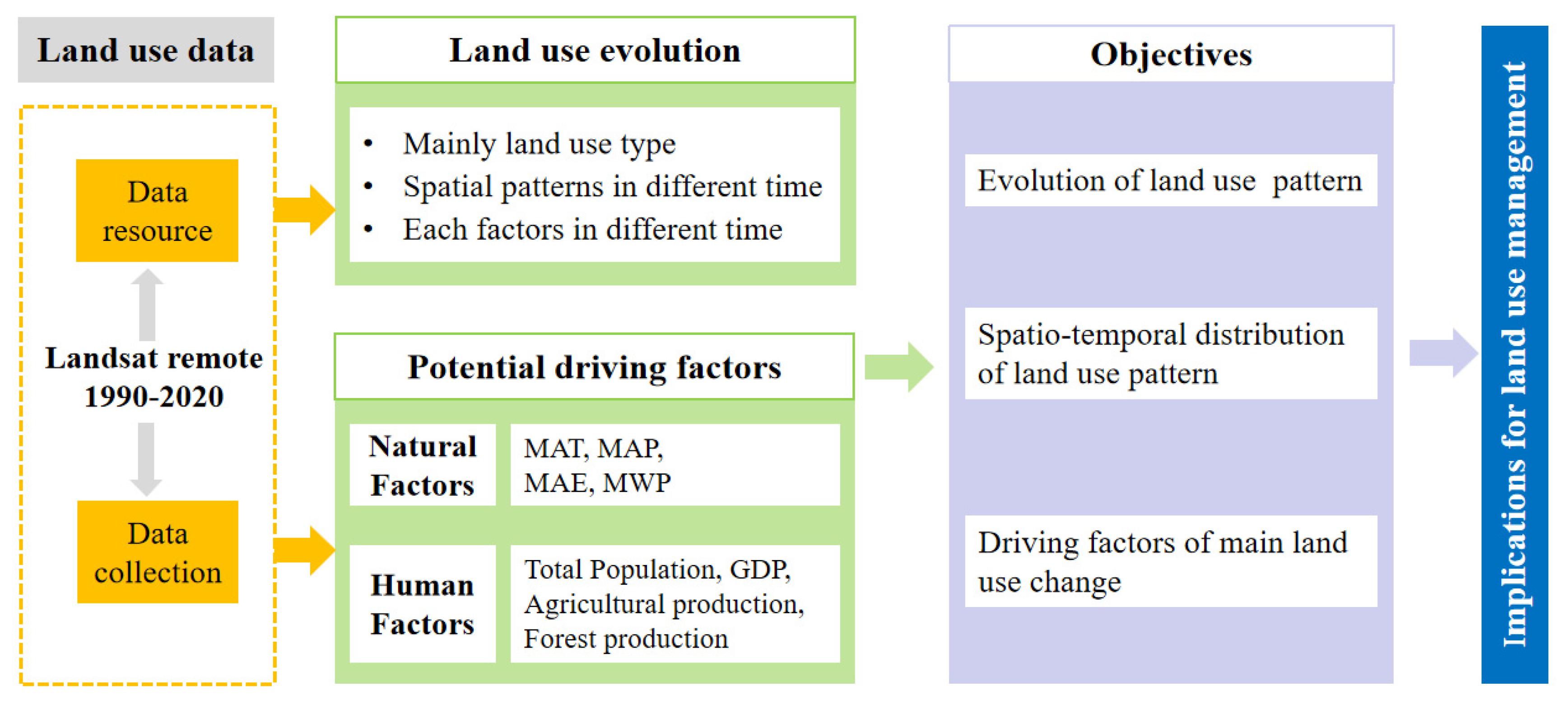
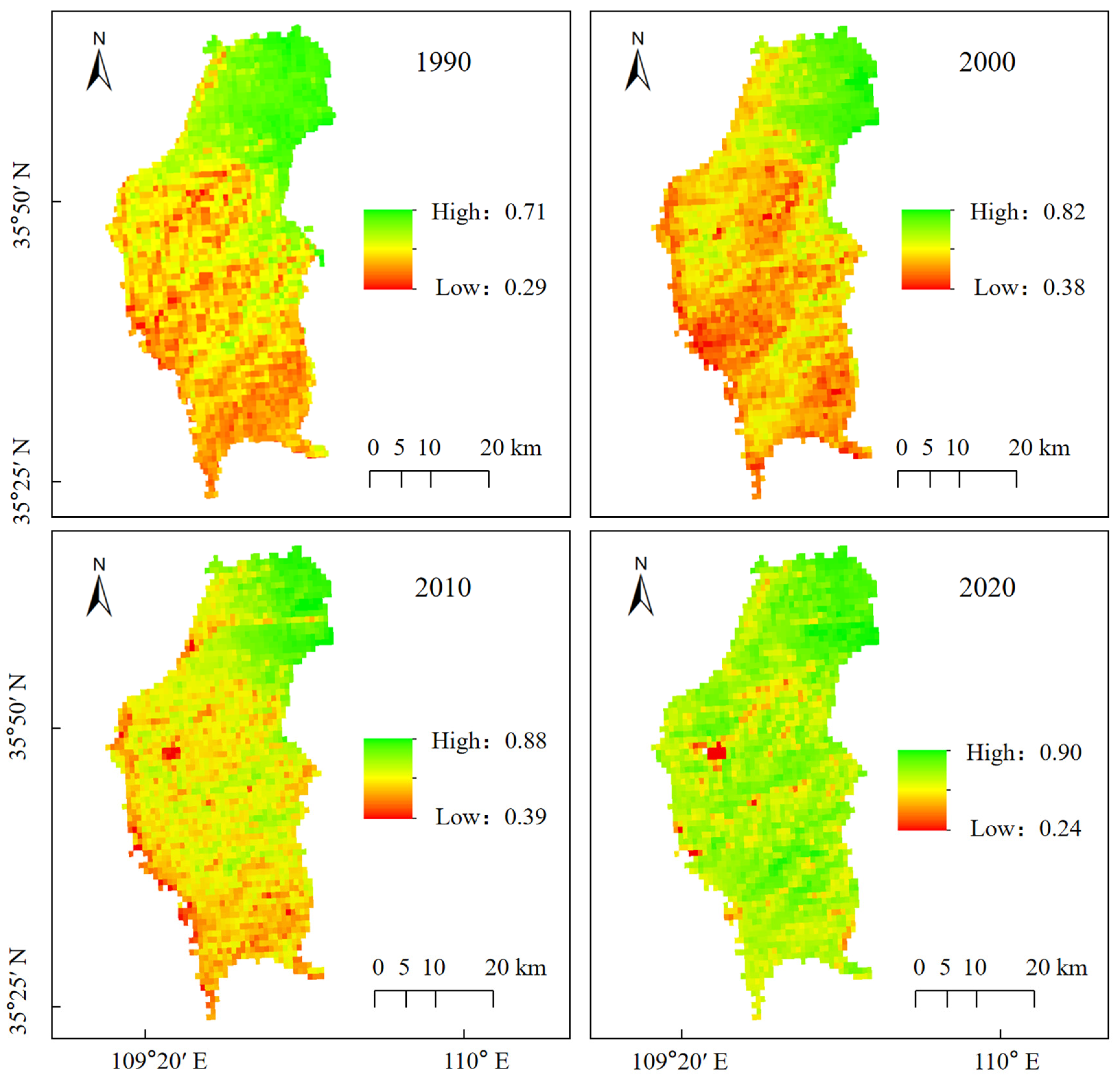



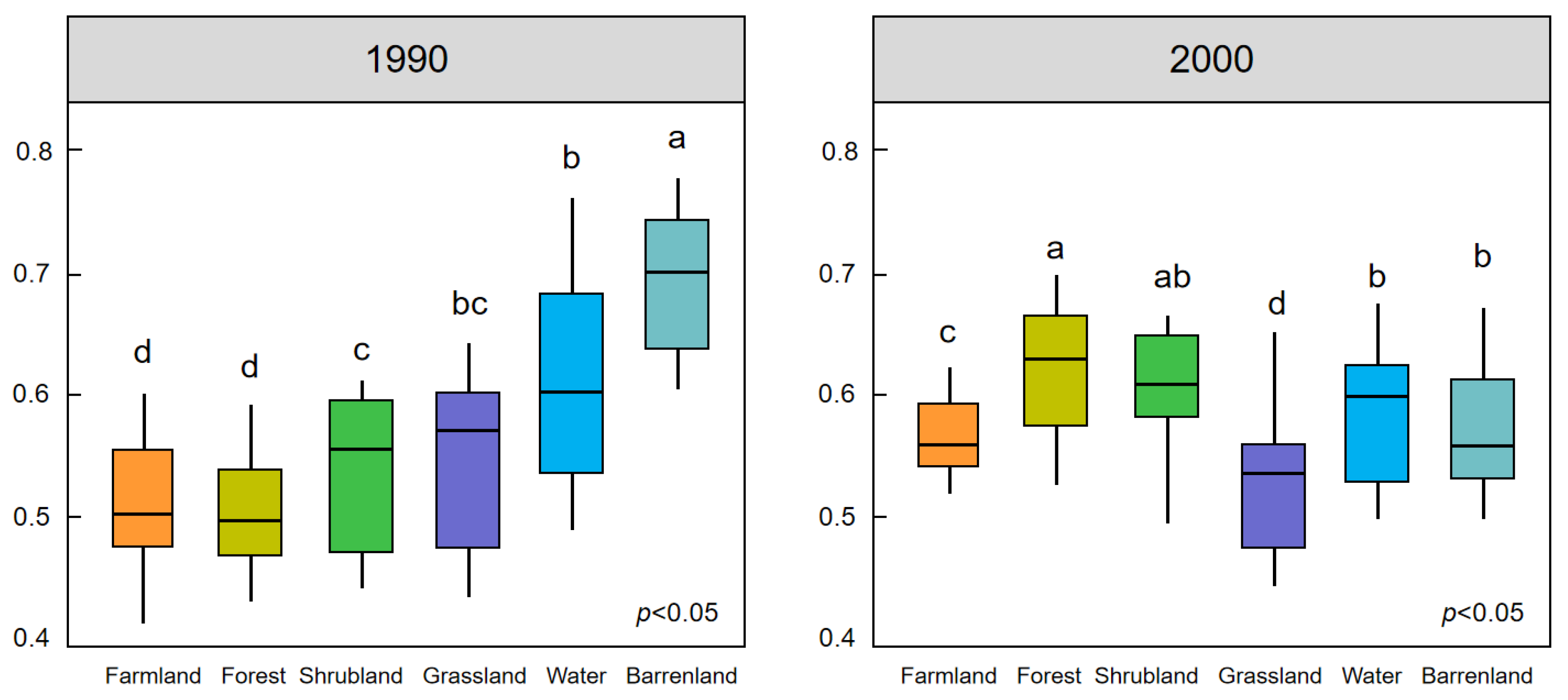
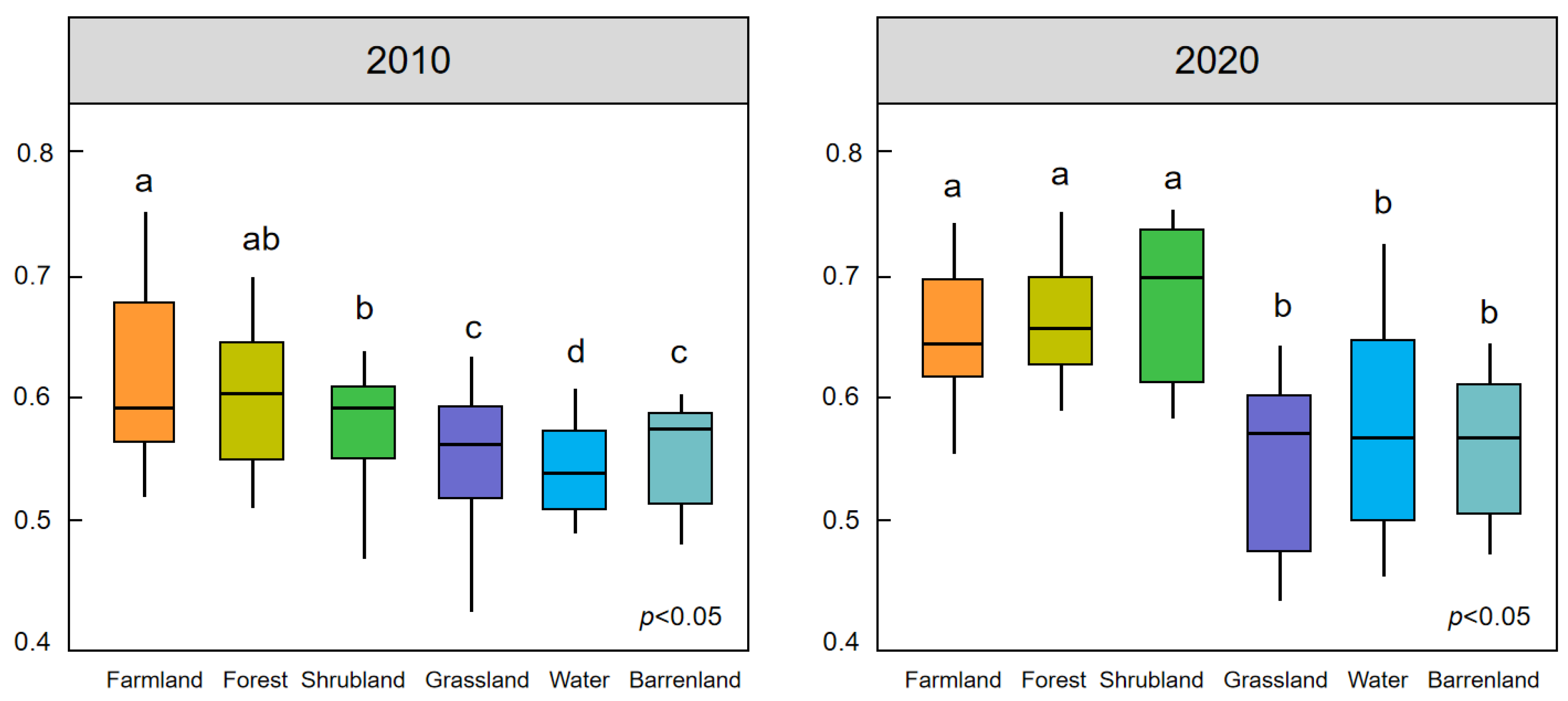
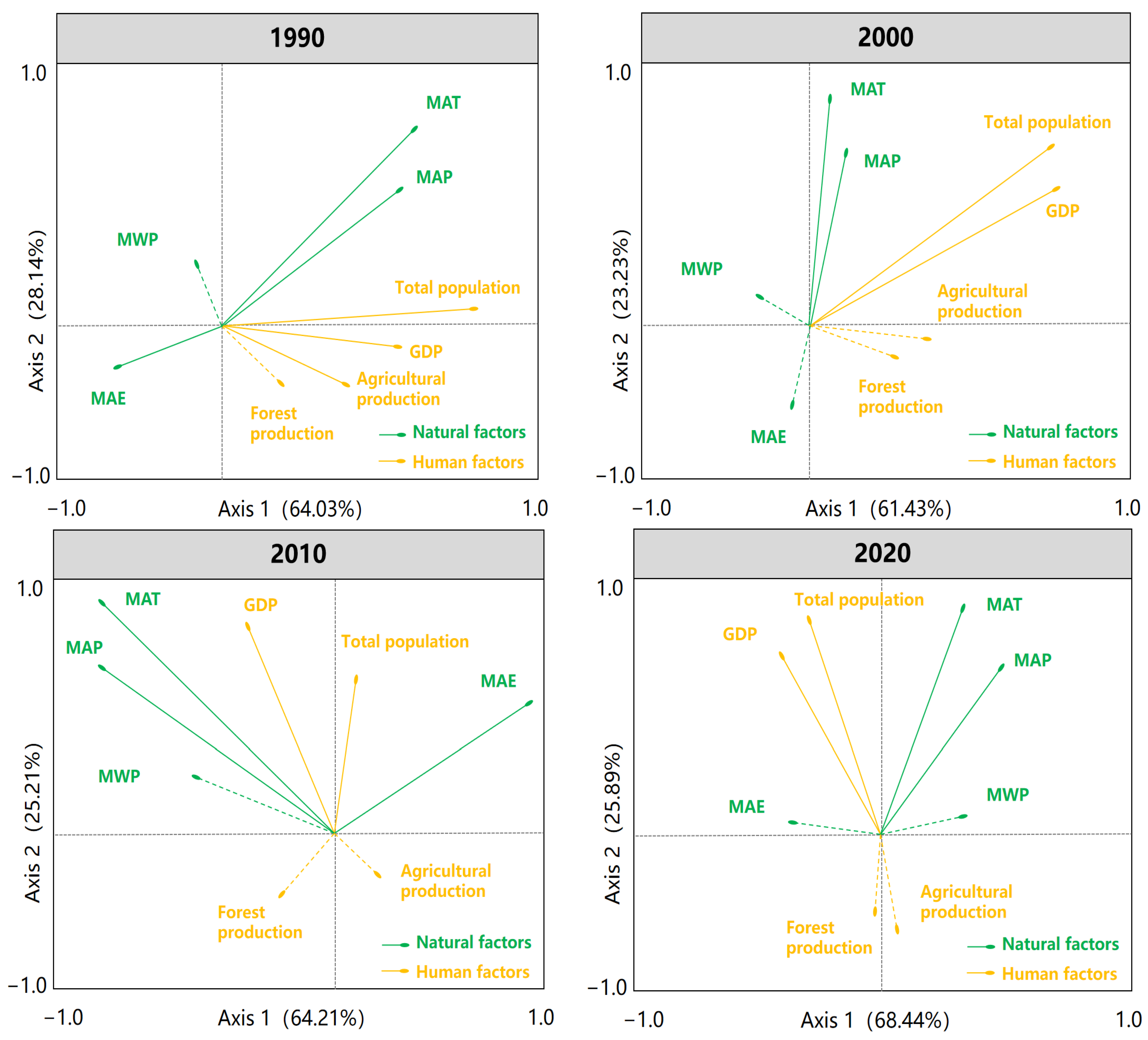
| Code | Type | Descriptions |
|---|---|---|
| 1 | Farmland | The land adopted for cultivation, such as mature cultivated land, recreational agricultural land, rotation land, grass field rotation crop land, fruit forest, and economic forest, as well as beach and seashore cultivated for over three years. |
| 2 | Forest | Forest land for growing trees. |
| 3 | Shrubland | Forest land for growing shrubs. |
| 4 | Grassland | All types of grassland under the dominance of growing herbs and coverage above 5%, including grassland and sparse forest grassland in pastoral areas with canopy density below 10%. |
| 5 | Water | Natural land waters, including water conservancy facilities. |
| 6 | Barrenland | The categories of land that are challenging to use or have not been developed in rural areas. |
| Item | 1990 | 2000 | 2010 | 2020 | |
|---|---|---|---|---|---|
| Farmland | Area (km2) | 719.93 | 744.95 | 677.76 | 687.40 |
| Proportion (%) | 39.91 | 41.29 | 37.57 | 38.10 | |
| Forest | Area (km2) | 490.09 | 502.37 | 596.14 | 638.70 |
| Proportion (%) | 27.17 | 27.85 | 33.05 | 35.40 | |
| Shrubland | Area (km2) | 5.11 | 7.96 | 3.52 | 1.91 |
| Proportion (%) | 0.28 | 0.44 | 0.20 | 0.11 | |
| Grassland | Area (km2) | 583.58 | 541.66 | 516.64 | 460.12 |
| Proportion (%) | 32.35 | 30.03 | 28.64 | 25.51 | |
| Water | Area (km2) | 2.80 | 2.13 | 2.09 | 1.97 |
| Proportion (%) | 0.16 | 0.12 | 0.12 | 0.11 | |
| Barrenland | Area (km2) | 2.50 | 4.93 | 7.84 | 13.90 |
| Proportion (%) | 0.14 | 0.27 | 0.43 | 0.77 | |
| Item | Driving Factors |
|---|---|
| Natural factors | MAT |
| MAP | |
| MAE | |
| MWP | |
| Human factors | Total Population |
| GDP | |
| Agricultural production | |
| Forest production |
| Item | Natural Factors | Human Factors | |||||||
|---|---|---|---|---|---|---|---|---|---|
| MAT | MAP | MAE | MWP | Total Population | GDP | Agricultural Production | Forest Production | ||
| Farmland change | Absolute relevance | 0.74 | 0.63 | 0.71 | 0.64 | 0.83 | 0.73 | 0.77 | 0.76 |
| Relative relevance | 0.75 | 0.67 | 0.68 | 0.63 | 0.78 | 0.79 | 0.67 | 0.64 | |
| Total relevance | 0.86 | 0.78 | 0.83 | 0.73 | 0.92 | 0.91 | 0.83 | 0.83 | |
| Forest change | Absolute relevance | 0.72 | 0.64 | 0.72 | 0.63 | 0.82 | 0.89 | 0.70 | 0.72 |
| Relative relevance | 0.76 | 0.76 | 0.74 | 0.64 | 0.86 | 0.85 | 0.68 | 0.68 | |
| Total relevance | 0.86 | 0.86 | 0.85 | 0.74 | 0.95 | 0.92 | 0.82 | 0.76 | |
| Shrubland change | Absolute relevance | 0.75 | 0.72 | 0.73 | 0.69 | 0.84 | 0.68 | 0.72 | 0.75 |
| Relative relevance | 0.76 | 0.75 | 0.79 | 0.765 | 0.85 | 0.76 | 0.74 | 0.71 | |
| Total relevance | 0.86 | 0.88 | 0.84 | 0.72 | 0.76 | 0.71 | 0.83 | 0.83 | |
| Grassland change | Absolute relevance | 0.71 | 0.69 | 0.71 | 0.61 | 0.82 | 0.82 | 0.76 | 0.74 |
| Relative relevance | 0.70 | 0.66 | 0.84 | 0.64 | 0.79 | 0.76 | 0.80 | 0.80 | |
| Total relevance | 0.83 | 0.85 | 0.88 | 0.71 | 0.91 | 0.87 | 0.85 | 0.89 | |
| Water change | Absolute relevance | 0.71 | 0.71 | 0.73 | 0.63 | 0.78 | 0.79 | 0.73 | 0.71 |
| Relative relevance | 0.72 | 0.72 | 0.75 | 0.65 | 0.87 | 0.82 | 0.75 | 0.76 | |
| Total relevance | 0.89 | 0.87 | 0.83 | 0.71 | 0.81 | 0.82 | 0.86 | 0.86 | |
| Barrenland change | Absolute relevance | 0.70 | 0.66 | 0.71 | 0.62 | 0.83 | 0.84 | 0.75 | 0.72 |
| Relative relevance | 0.68 | 0.67 | 0.79 | 0.65 | 0.77 | 0.76 | 0.82 | 0.76 | |
| Total relevance | 0.76 | 0.84 | 0.84 | 0.75 | 0.94 | 0.93 | 0.83 | 0.82 | |
| Item | Dependent Variable Y | Intercept | Independent Variable X | R2 | F | p Value | |
|---|---|---|---|---|---|---|---|
| Natural Factor X1 | Human Factor X2 | ||||||
| 1990–2000 | Y (farmland → forest) | 0.15 | 0.12 (B) ** | - | 0.64 | 16.5 | 0.003 |
| Y (farmland → shrubland) | 0.42 | 1.32 (A) * | - | 0.63 | 9.4 | 0.04 | |
| Y (farmland → grassland) | 0.08 | 0.76 (B) ** | - | 0.73 | 11.2 | 0.005 | |
| 2000–2010 | Y (farmland → forest) | 0.45 | 0.43 (B) | 0.74 (E) ** | 0.76 | 23.2 | 0.002 |
| Y (farmland→shrub) | 1.45 | - | 0.75 (E) ** | 0.78 | 19.8 | 0.005 | |
| Y (farmland → grassland) | 0.78 | - | 0.86 (E) ** | 0.75 | 16.5 | 0.004 | |
| 2010–2020 | Y (farmland → forest) | 1.21 | - | 0.42 (G) ** | 0.65 | 21.4 | 0.008 |
| Y (farmland→shrub) | 0.96 | - | 0.78 (G) ** | 0.76 | 15.6 | 0.007 | |
| Y (farmland → grassland) | 1.14 | 0.34 (B) * | 0.81 (E) ** | 0.68 | 9.3 | 0.005 | |
Disclaimer/Publisher’s Note: The statements, opinions and data contained in all publications are solely those of the individual author(s) and contributor(s) and not of MDPI and/or the editor(s). MDPI and/or the editor(s) disclaim responsibility for any injury to people or property resulting from any ideas, methods, instructions or products referred to in the content. |
© 2024 by the authors. Licensee MDPI, Basel, Switzerland. This article is an open access article distributed under the terms and conditions of the Creative Commons Attribution (CC BY) license (https://creativecommons.org/licenses/by/4.0/).
Share and Cite
Xue, Y.; Ma, W.; Liu, L.; Yang, Y. Land Use Evolution and Its Driving Factors over the Past 30 Years in Luochuan County. Forests 2024, 15, 1346. https://doi.org/10.3390/f15081346
Xue Y, Ma W, Liu L, Yang Y. Land Use Evolution and Its Driving Factors over the Past 30 Years in Luochuan County. Forests. 2024; 15(8):1346. https://doi.org/10.3390/f15081346
Chicago/Turabian StyleXue, Yuhang, Wenbao Ma, Liangxu Liu, and Yang Yang. 2024. "Land Use Evolution and Its Driving Factors over the Past 30 Years in Luochuan County" Forests 15, no. 8: 1346. https://doi.org/10.3390/f15081346
APA StyleXue, Y., Ma, W., Liu, L., & Yang, Y. (2024). Land Use Evolution and Its Driving Factors over the Past 30 Years in Luochuan County. Forests, 15(8), 1346. https://doi.org/10.3390/f15081346








